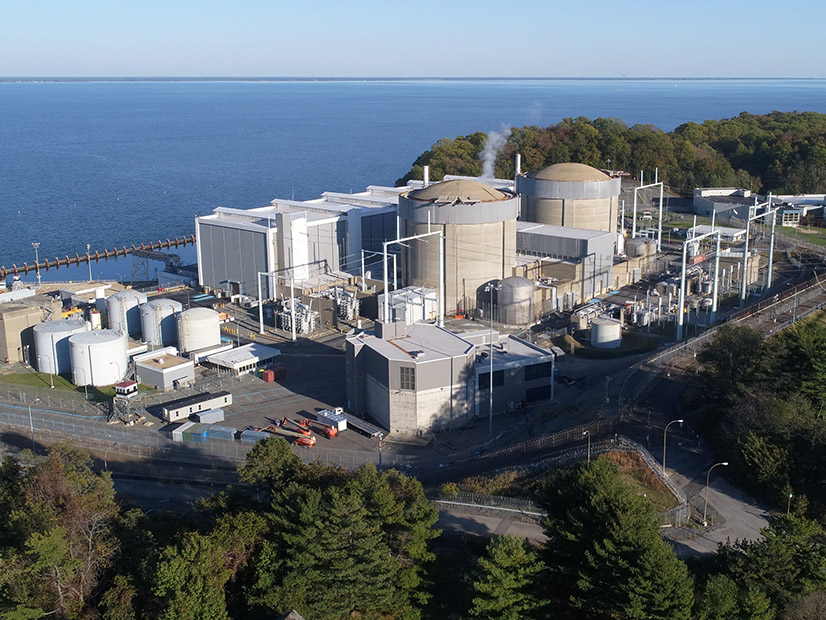Exelon on Sept. 30 filed a petition for a declaratory order from FERC on its dispute with Constellation Energy over the latter’s effort to co-locate major loads at two of its nuclear plants (EL24-149).
The two firms, which used to be one before Exelon spun off its generation and competitive retail businesses into Constellation, have been on opposite sides of the debate on co-location from a purely policy level. (See Talen Energy Deal with Data Center Leads to Cost Shifting Debate at FERC.)
But Exelon’s petition lays out the actual business dispute. Constellation is seeking to co-locate new loads at its Calvert Cliffs Nuclear Power Plant in Maryland and Limerick Nuclear Power Plant in Pennsylvania. Those plants are connected to the grid owned by Exelon’s Baltimore Gas & Electric (BGE) and PECO Energy utilities, respectively.
Neither the petition, nor the legal correspondence filed alongside it, mention data centers specifically with the modifications. But Exelon argued that Constellation’s moves could harm new and existing customers, including data centers. The economics of co-locating data centers at nuclear plants are lucrative, as a deal with Microsoft was enough to get Constellation to reopen the recently retired unit at Three Mile Island, Exelon said.
“Constellation has wrongly claimed that the existing interconnection agreements between the petitioning utilities and predecessors of Constellation (and, in the case of Calvert, PJM) entitle it to connect new end-use load without regard to the purpose and terms of the existing interconnection agreements or to the retail nature of the interconnection and requested services involved,” Exelon said in its petition.
Exelon wants FERC to find that PJM’s generator interconnection procedures under Order 2003 only apply to end-use generation, not load. FERC also should declare that interconnection of end-use load is a matter of state, not federal jurisdiction, the company argued.
Under the Federal Power Act, FERC is required to respect states’ role to regulate retail rates, Exelon said. Order 2003 itself was aimed at ensuring fair competition for generation, and FERC should make clear that it does not apply to end-use customers, it argued.
Exelon also asked FERC to find that a request to reconfigure existing generator interconnections to accommodate the co-located large, new loads would require modification of the relevant interconnection agreements to reflect the new interconnection facilities and the changed nature and purpose of the interconnection. That requires the consent of all the parties to such deals, the company argued, urging FERC to declare that as well.
The company said it supports the efforts of retail customers who chose to co-locate at generators when that can be accomplished safely and reliably and when load pays for its fair share of the costs of the electric grid, as defined by the applicable state and federal rates.
“Fortunately, the standard process of adding end-use load to the system is well understood and can be accomplished quickly while protecting system reliability and other customers,” Exelon said. “That process requires only that the load becomes a retail customer of the relevant distribution utility or cooperative, pay rates under existing tariffs, and that the interconnection be studied for safety and reliably.”
Changing the interconnection agreements to include large new loads transforms such deals into three-legged arrangements connecting end-use load, generation and the grid, which is significantly different from plugging a generator on its own to the grid, Exelon said.
Both BGE and PECO received requests for such co-locations, and they asked questions that would reflect the standard process for load additions, in which the customer itself or its agent asks the local distribution utility for service and describes the nature of the load and other factors.
Constellation took exception to those requests, saying the two utilities were not allowed to “condition performance of [interconnection agreement] obligations,” Exelon said. Constellation argued it was not required to arrange for retail service for the co-located load deals it is pursuing, according to Exelon.
“By its plain terms, PJM’s tariff does not and could not contemplate interconnection of end-use load through the generation interconnection process,” Exelon said. “Moreover, in its letter concerning Calvert Cliffs, Constellation has also declared that it may resort to litigation or referrals, including supposed antitrust claims, if BGE does not immediately take steps to provide the service Constellation requests.”
The controversy reflects a fundamental disagreement on the law, which includes foundational principles of jurisdiction, in the context of matters of serious import, Exelon argued.
It “respectfully request[ed] that the commission issue declarations that will settle this controversy, which threatens to cloud and undermine the jurisdictional and regulatory division between the states and the federal government embodied in the FPA, and which promises widespread, protracted litigation because requests to modify generator interconnections to accommodate co-located end-use load are becoming increasingly common,” Exelon told FERC. “By eliminating any confusion created by Constellation’s attempts to shift costs of co-located load at its generator interconnections, the commission can speed the energy transition, ensure reliability and protect all customers.”




